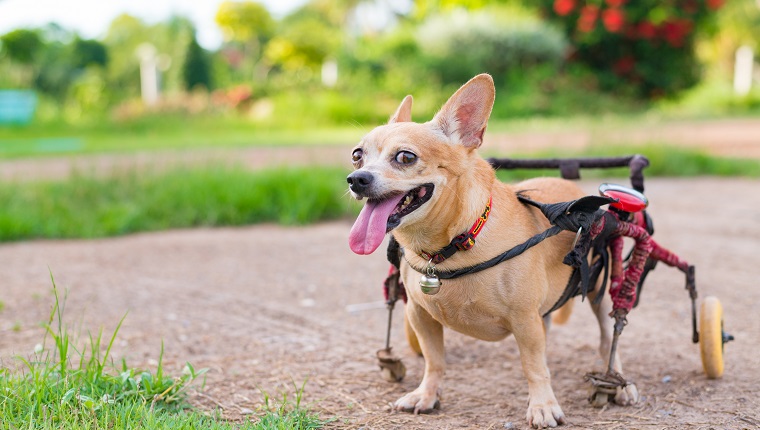Dogs are family, and we love them as much when they’re puppies as when they’re seniors. Medical and technological advancements have made the golden years for dogs much more golden, indeed. There are so many treatment and aid options now for many ailments our seniors may face.
One aspect of aging that can depress dog parents is mobility issues. Certain health conditions can make it difficult or even impossible for our dogs to walk.
However, dog wheelchairs and other mobility aids have become much more popular and easy to obtain as of late. If you’re wondering whether your dog needs a wheelchair and how you can go about getting one, here are a few things you should know.
What Are Some Signs Your Dog May Need A Wheelchair?

Your vet will be a great partner in determining if your dog would benefit from the use of a wheelchair or other mobility assistance device. Sometimes, a vet may advise against such a device, as in cases where they want the dog to build muscle for a temporary injury.
However, with some aging or permanent injuries, a wheelchair might be a dog’s best bet at staying mobile. If you see any of these signs, be sure to talk to your vet ASAP about a mobility device plan:
- Sudden change in behavior or irritability, especially when moving or putting weight on legs and joints
- Difficulty standing up
- Difficulty keeping balance
- Reluctance to go outside
- Fear or reluctance around stairs, uneven terrain, or slippery surfaces
- Weakness or muscle atrophy
- Paralysis
What Are Some Conditions That May Cause Difficulty Walking?
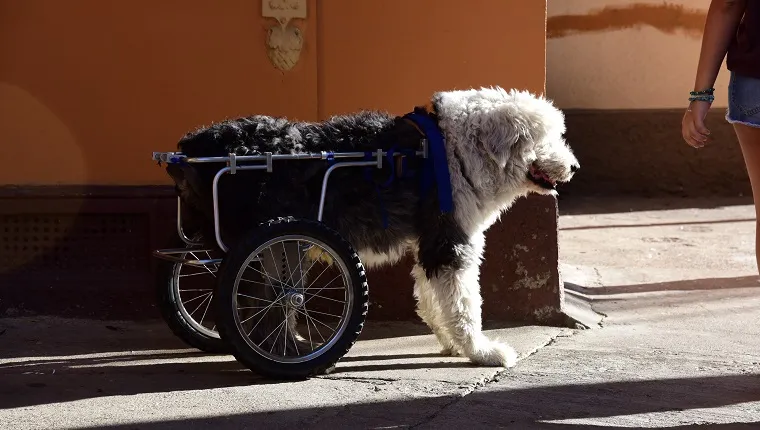
While the challenges of “old age” can often be a cause of difficulty walking for dogs, there are specific conditions that can cause these problems too.
They include:
- Arthritis
- Hip dysplasia
- Intervertebral disc disease (IVDD)
- Degenerative myelopathy (DM)
- Neurological disorders (such as spinal muscular atrophy)
- Paralysis
- Knee and ACL injuries
- Surgical recovery
- Injury due to accident or trauma
- Spinal problems
- Amputation
How Can You Evaluate If Your Dog May Benefit From A Mobility Aid?
One “easy” way to evaluate your dog at home is the towel test, which you can see in the video above. This simple method works by putting a towel flat underneath your dog’s abdomen, lifting lightly, and encouraging them to walk. Their backs should be flat; do not elevate their hind end too much — just barely off the ground.
If they can walk with their front legs just fine while you’re supporting their back end, then they only need rear support, either from a wheelchair or a different option.
If their front legs splay or buckle, or if they still have trouble walking while you’re supporting their hind end, then they may benefit from more of a full-body support.
What Are Different Mobility Aid Options?
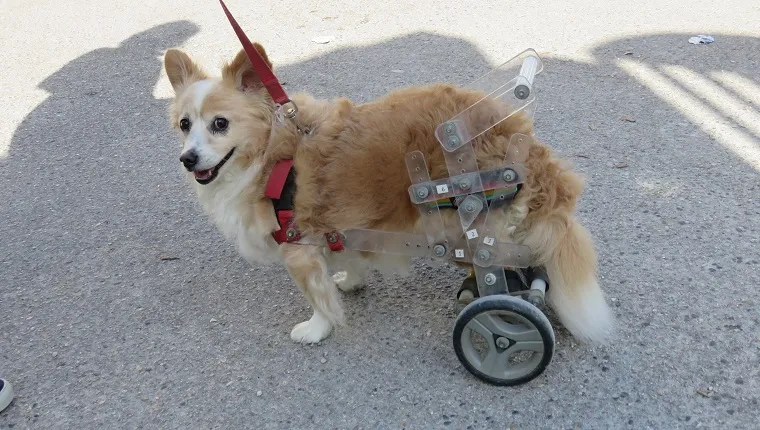
There are many great options for mobility aids for your pet. In addition to the “towel test” described above, working with your vet can help you determine the best option for your dog.
A lot may also depend on the size of your dog; for example, size can determine whether it’s realistic to support their weight with a lifted option.
There are two basic categories of mobility devices for dogs: wheelchairs or carts and slings or harnesses.
There are a few sub-categories within those, depending on how much help your dog needs.
Wheelchairs
For wheelchairs, if your dog only needs support of their back end, then a two-wheel rear mobility device would be ideal. This way, your dog still gets full exercise of their front limbs without the additional stress and strain of dragging their hind end.
If your dog struggles with walking on their front end, too, including splayed or buckling limbs, then a four-wheel wheelchair would best suit them. This provides support throughout their entire body while still allowing them some level of exercise and freedom of mobility.
Harnesses
As with wheelchairs, there are different levels of support with harnesses or slings. Some can support just the back end, while some can support the entire body.
If your dog only needs support in the back, a sling that goes around their abdomen, much like the “towel test” can be a versatile, easy option.
If your dog needs more complete support, a full-body harness can provide varying levels of support, depending on the option you choose. Some have multiple handles, so you can adjust which end of your dog you’re supporting more, which can be helpful in situations like going up stairs.
Harnesses may be a more realistic option for smaller dogs, as it could be difficult to lift a larger dog’s weight; however, you could consider it a built-in workout for yourself, too!
How Do You Get A Wheelchair Or Other Mobility Aid For Your Dog?
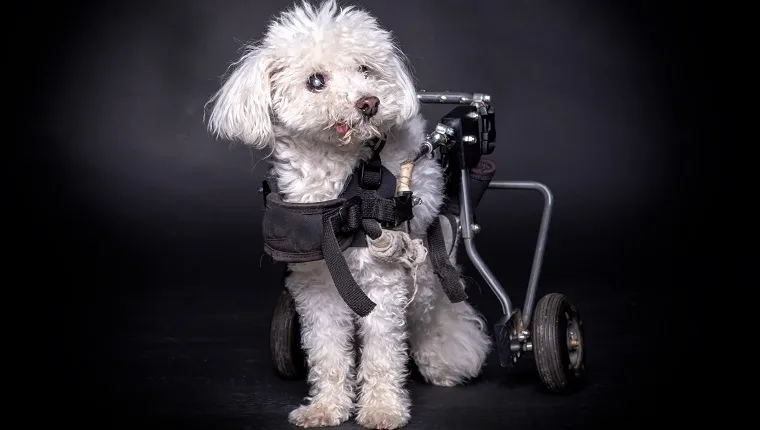
In addition to helping you evaluate your dog’s level of need, your vet may be able to connect you to a vendor or designer of dog wheelchairs.
The American Kennel Club has a great list of different options to consider, with recommendations based on the size and stature of the dog in need. In addition to those listed by the AKC, Eddie’s Wheels for Pets is a popular brand.
The process is easier than you might think: search “wheelchair for dogs” on the internet, browse the options, consult with your vet on which might be the best option for your dog, and make your selection.
Many of the brands list sizing and mobility-need guides on their websites, and, even better, they provide contact info so you can contact them for a personalized recommendation.
If your dog only needs temporary support, you can consider renting a device, too.
How Can You Help Your Dog Adjust To A Wheelchair?
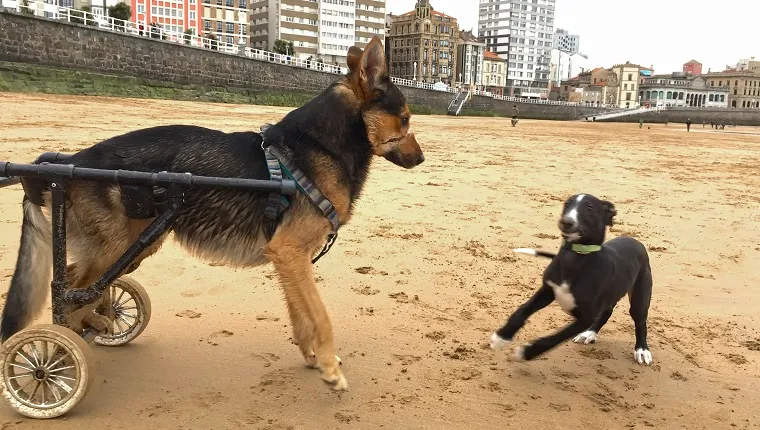
It’s important to supervise your dog while they’re using their wheelchair, in case they show fatigue or want to lie down.
To get them started, it’s best to try two ten-minute intervals for the first few days. This will help your dog get acclimated without causing excess stress or exhaustion.
Even after your dog is familiar with the wheelchair, these devices are not intended for all-day use. It’s best to use them for limited sessions of exercise, socialization, exploration, or playing, making sure to let your dog rest outside of those sessions.
If your dog had an energetic session, they’re likely ready to rest and lie down, anyway. While some smaller dogs may be able to lie down in their wheelchairs, larger dogs will not, and it’s not really recommended, anyway.
Also, be sure to watch out for steep inclines, as well as obstacles or surfaces that may get the wheels stuck. Some of this may be discovered through trial and error. As long as you’re watching your dog, you should be able to help them out of a tricky situation before they’d get seriously hurt.
Quality Of Life
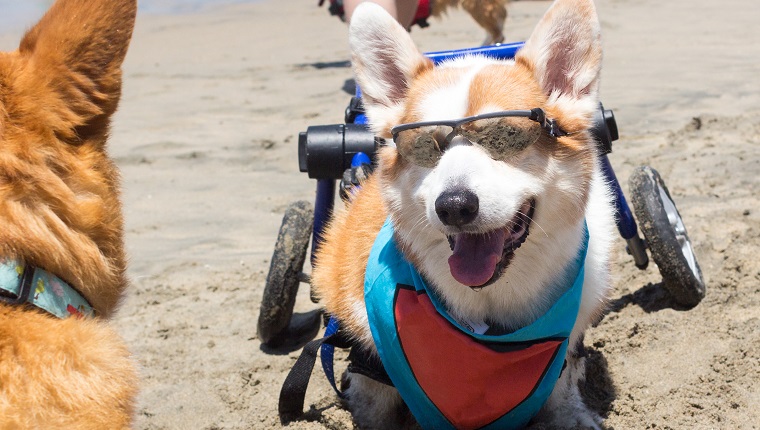
A difficult concept for a lot of pet parents to fathom is quality of life. Your vet can help you determine if a mobility device is best for your pet, or if there are more severe ailments involved and euthanasia might be a kinder option.
However, if your dog still shows a zest for life and general happiness, there’s no reason mobility difficulty needs to stop them. Mobility devices can be fantastic tools to give your dog freedom to explore the world.
They’re also great physical therapy devices when used correctly. If your dog wasn’t able to walk much without a device, they’ll still get exercise and build muscle while using a device.
These devices are specially designed to allow your dog to go potty, too, without leaving your dog stuck in an uncomfortable mess.
There are other important steps you can take to make your dog more comfortable, as well. You can add supplements that help with arthritis and joint pain into their diet, as well as ensuring their regular food is targeted for seniors.
Adding a ramp for areas where your dog usually has to jump, like the couch or bed, will also decrease the stress on their joints. You can add some gentle massage into your cuddle sessions for added pain relief.
With the right tools, you can help your senior dog enjoy their golden years as much as you enjoy them. Once they’re used to their wheelchair or sling, they may hardly notice a difference from their earlier years. After all, there are so many smells and sights to chase outside; all they’ll focus on is the journey!
Have you ever thought about getting a wheelchair for your dog? How do you help your pooch stay mobile? Let us know in the comments below!
